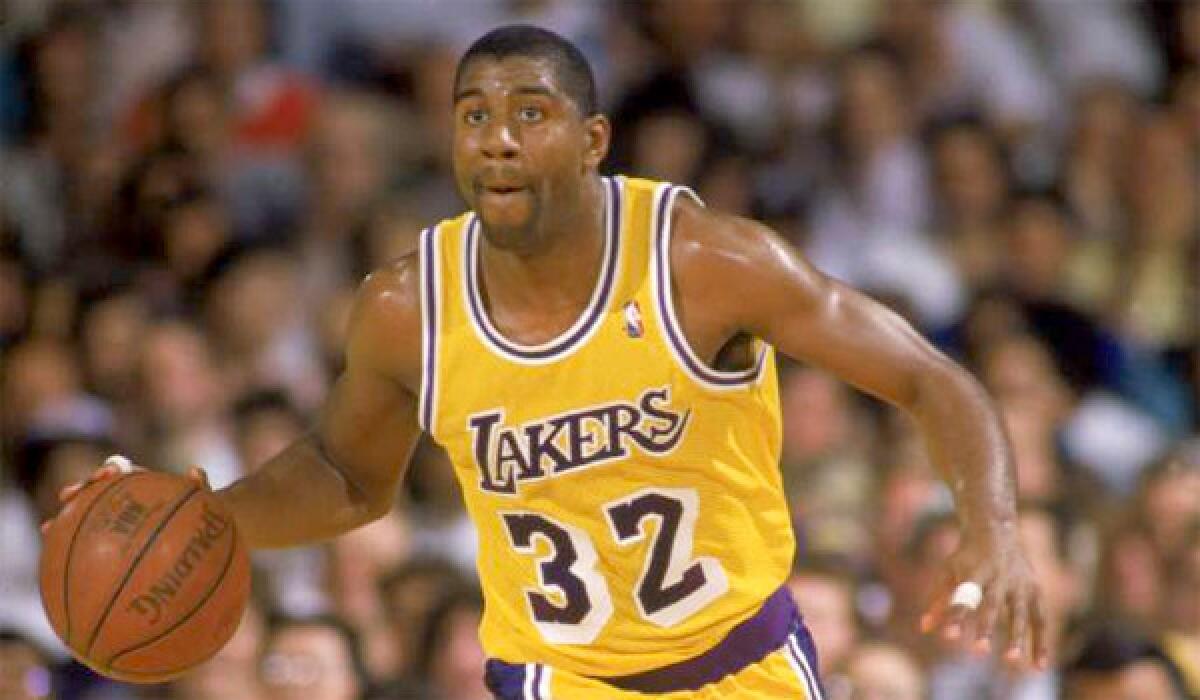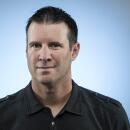Lakers have rebuilt on the fly before, but latest fix won’t be quick

- Share via
The Lakers are a basketball mess. They’ve used 21 lineups in 42 games. They’re 13th in the Western Conference. Kobe Bryant is at least two weeks away from returning from another injury, as are Steve Blake and Jordan Farmar. Steve Nash also hopes to come back next week, but if that fails. . . ?
It’s no wonder Lakers fans are starting to dream of college stars Jabari Parker, Joel Embiid and Andrew Wiggins.
The fans hoped it wouldn’t be this way earlier this season.
Their team was a surprisingly resilient 10-9 just before Christmas when Bryant came back from an Achilles’ tendon injury, but he lasted six games before sustaining a fractured knee. He’ll have missed another six or seven weeks because of that knee injury, surely sinking the Lakers’ already marginal playoff chances.
The team has also suffered from a revolving door at point guard all season because of injuries. Blake has missed 21 games, Farmar has been sidelined for 20, and soon-to-be 40-year-old Nash has played in only six games.
The Lakers didn’t practice Tuesday, but their season seems headed nowhere except for a long line to the trainer’s room and an eventual spot in the draft lottery.
Still worried about their future? If history is a guide, it’ll take a while for the Lakers to get out of this jam — but it can be done. There’s even an outline for turning around this current mess.
So let’s take a look at three quick turnarounds the franchise made in past decades to get back to its championship ways:
1978-79 (47-35 record)
Sad times: Only the Lakers would consider a 47-35 record a losing season, but they finished third in the Pacific Division, went 3-5 in the playoffs and burned through a fourth fruitless season with Kareem Abdul-Jabbar, who hadn’t gone to the NBA Finals since arriving from Milwaukee.
How long the turnaround took: One year. The Lakers won the championship in 1980.
How they did it: It was as simple as one player.
The Lakers drafted Magic Johnson with the first overall pick in 1979 despite some internal debate that they should have selected Sidney Moncrief. All Johnson did was amass 42 points, 15 rebounds and seven assists against Philadelphia in Game 6 of the NBA Finals while playing center because Abdul-Jabbar was sidelined by a sprained ankle.
Commence Johnson’s legendary status.
The Lakers would win four more championships with Johnson and Abdul-Jabbar in eight total Finals appearances in the 1980s.
Historical draft footnote: How did the Lakers get that top pick in 1979 despite tying Denver, Houston and Philadelphia for the NBA’s sixth-best record? It was future compensation from New Orleans after the Jazz signed Gail Goodrich as a free agent in 1976. The Jazz finished a lowly 26-56 in 1978-79 and the Lakers won a coin flip with Chicago for the top pick in the pre-lottery days.
1993-94 (33-49)
Sad times: The end of the “Showtime” era became painfully obvious as the Lakers went through three coaches in one season and finished with their second-worst winning percentage since moving to L.A. in 1960. Not even Magic Johnson could help as a coach, going 5-11 after taking over for interim coach Bill Bertka (1-1), who had taken over for Randy Pfund (27-37).
How long the turnaround took: Six years. They won the NBA title in 2000, their first season with Phil Jackson as coach.
How they did it: Two flash points — the summer of 1996 and the summer of 1999.
Lakers executive Jerry West acquired Kobe Bryant (the 13th overall pick) in a draft-day trade in 1996 with the Charlotte Hornets for Vlade Divac. Three weeks later, West signed free agent Shaquille O’Neal to a seven-year, $120-million contract. Not a bad haul.
It then took three seasons, two embarrassing playoff sweeps (Utah in 1998, San Antonio in 1999) and a legendary appalling “1, 2, 3 . . . Cancun!” chant by guard Nick Van Exel as they were about to be eliminated, before the Lakers hired someone who could turn O’Neal and Bryant into champions.
Jackson arrived on June 16, 1999, 3½ weeks after the Lakers were crushed by the Spurs in the Western Conference semifinals. He came with the well-known pedigree of six championships in Chicago.
He spoke of Zen, he burned sage in the Lakers’ training facility if bad vibes needed expunging and he kept Bryant and O’Neal from killing each other for three consecutive title runs (2000, 2001, 2002).
Other key pickups along the way: Robert Horry (trade with Phoenix, 1997), Rick Fox (free agent, 1997), Brian Shaw (free agent, 1999) and the drafting of Derek Fisher (1996).
2004-05 (34-48)
Sad times: Shaquille O’Neal was traded in July 2004 to Miami and Phil Jackson was already out the door a few weeks before that. It was inevitable that struggle would follow, but who knew it would come in the form of calamity? Coach Rudy Tomjanovich quit halfway through the season, Kobe Bryant seemingly took 50 shots a game, and the Lakers lost 19 of 21 to end it.
How long the turnaround took: A few years. The Lakers were back in the NBA Finals in 2008 and won titles in 2009 and 2010.
How they did it: A little of everything — decent lottery pick, angry superstar and miracle trade.
Their failure in 2004-05 led to the 10th pick in the draft and an overweight high school kid named Andrew Bynum. He turned out to be injury-prone but a steady center when healthy.
Bryant didn’t think much of him, though, angrily daring the Lakers to ship Bynum out before demanding to be traded himself in the summer of 2007.
With pressure mounting from the always-smoldering Bryant, the Lakers swung the deal that pole-vaulted them back to prominence: Pau Gasol arrived from Memphis in February 2008 for the cheap package of Kwame Brown, Javaris Crittenton, Aaron McKie and first-round picks in 2008 and 2010.
The Grizzlies also received the rights to Marc Gasol, the then-chunky younger brother of Pau who eventually became a top-line NBA center.
With Jackson back in the fold since 2005 and Derek Fisher rejoining his old team in 2007, Gasol was the final piece, a skilled big man to help Bryant get his fourth and fifth championship rings.
2013-14 (currently 16-26)
Sad times: This . . . is . . . ugly. You’re a prophet if you saw this coming 1½ years ago when the franchise acquired Dwight Howard and Steve Nash to pair with Kobe Bryant and Pau Gasol.
How long the turnaround will take: Years. Quite a few.
How the Lakers must do it: They’ll need the Special Ks — potential free agents Kevin Love in 2015 and Kevin Durant in 2016. This summer is basically irrelevant with LeBron James almost surely not coming to L.A. and Carmelo Anthony’s stock moving sideways at best. Maybe Luol Deng, a nice all-around player but not a superstar, can be wooed from Cleveland in July.
Sorry, Lakers fans. This isn’t a quick one-year fix.
But the team holds a first-round pick for the first time since 2007 and the draft looks solid if you’re a bottom-dweller. Hope springs eternal for the Lakers in the form of drafting a talented 19-year-old or 20-year-old if the losses keep coming with the present-day old-timers.
Twitter: @Mike_Bresnahan
More to Read
Go beyond the scoreboard
Get the latest on L.A.'s teams in the daily Sports Report newsletter.
You may occasionally receive promotional content from the Los Angeles Times.











